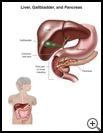
Liver Biopsy
________________________________________________________________________
KEY POINTS
- A liver biopsy is a procedure done to remove a sample of liver tissue for examination under a microscope. It is used to test for liver diseases.
- Ask your child’s healthcare provider how long it will take to recover and how to take care of your child at home.
- Make sure you know what symptoms or problems you should watch for and what to do if your child has them.
- Ask your child’s healthcare provider when the results of the biopsy will be available.
________________________________________________________________________
What is a liver biopsy?
A liver biopsy is a procedure done to remove a sample of liver tissue for examination under a microscope.
When is it used?
This procedure is used to test for liver diseases such as cirrhosis, hepatitis, fatty liver disease, and tumors. It is also used to check the progress of treatment in diseases such as chronic hepatitis.
How do I prepare my child for this procedure?
- Tell the provider if your child has any food, medicine, or other allergies such as latex.
- Tell the provider if your child has had kidney problems or an allergy to chemicals such as contrast dye. Contrast dye is used for some scans.
- Tell your child’s healthcare provider if your older child is or may be pregnant or is breastfeeding.
- Your child may or may not need to take regular medicines the day of the procedure. Tell the healthcare provider about all medicines and supplements your child takes. Some products may increase your child’s risk of side effects. Ask the healthcare provider if your child needs to avoid taking any medicine or supplements before the procedure.
- Follow any instructions your child’s healthcare provider may give you.
- Ask any questions you have before the procedure. You should understand what the healthcare provider is going to do. You have the right to make decisions about your child’s healthcare and to give permission for any tests or procedures.
What happens during the procedure?
Your child will be given medicine called anesthesia to keep from feeling pain during the procedure. General anesthesia relaxes the muscles and puts your child into a deep sleep.
The provider may make a small cut in your child’s belly and insert a thin needle into your child’s liver. Sometimes a liver biopsy is done by inserting a needle through a neck vein and down into the liver. A sample of liver tissue is removed and examined under a microscope in a lab.
Usually the procedure is done with a CT or ultrasound scan to help guide the needle. It might also be done during a surgical procedure while your child is asleep.
What happens after the procedure?
After the biopsy, your child may need to lie on his or her right side for several hours and then on his or her back for a while longer to prevent or decrease bleeding. Your child’s blood pressure, pulse, and breathing will be monitored. Your child will be given medicine for pain if needed.
Follow the healthcare provider's instructions. Ask the healthcare provider:
- How and when you will get your child’s test results
- How long it will take to recover
- If there are activities your child should avoid and when your child can return to normal activities
- How to take care of your child at home
- What symptoms or problems you should watch for and what to do if your child has them
Make sure you know when your child should come back for a checkup. Keep all appointments for provider visits or tests.
What are the risks of this procedure?
Every procedure or treatment has risks. Some possible risks of this procedure include:
- Your child may have problems with anesthesia.
- Your child may have an infection or bleeding.
- Other parts of your child’s body may be injured during the procedure.
Ask the healthcare provider how these risks apply to your child. Be sure to discuss any other questions or concerns that you may have.
Last modified: 2022-01-03
Last reviewed: 2019-03-07

